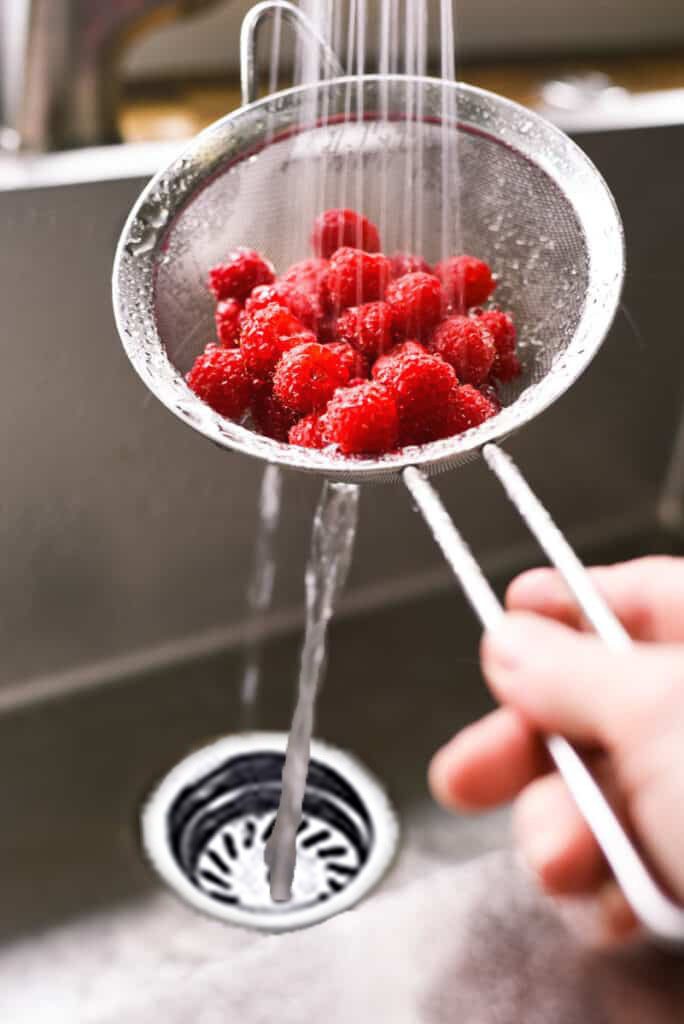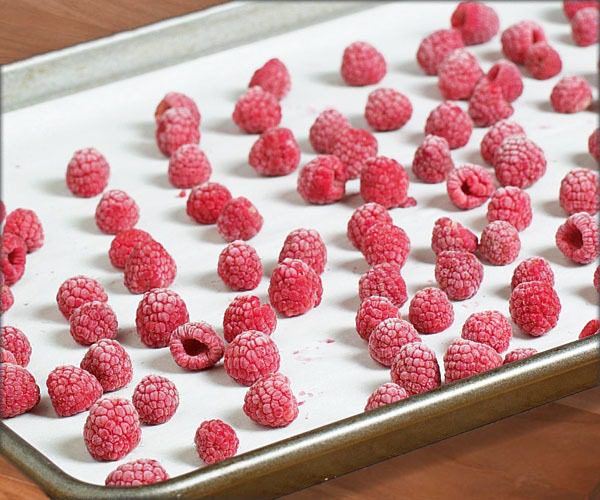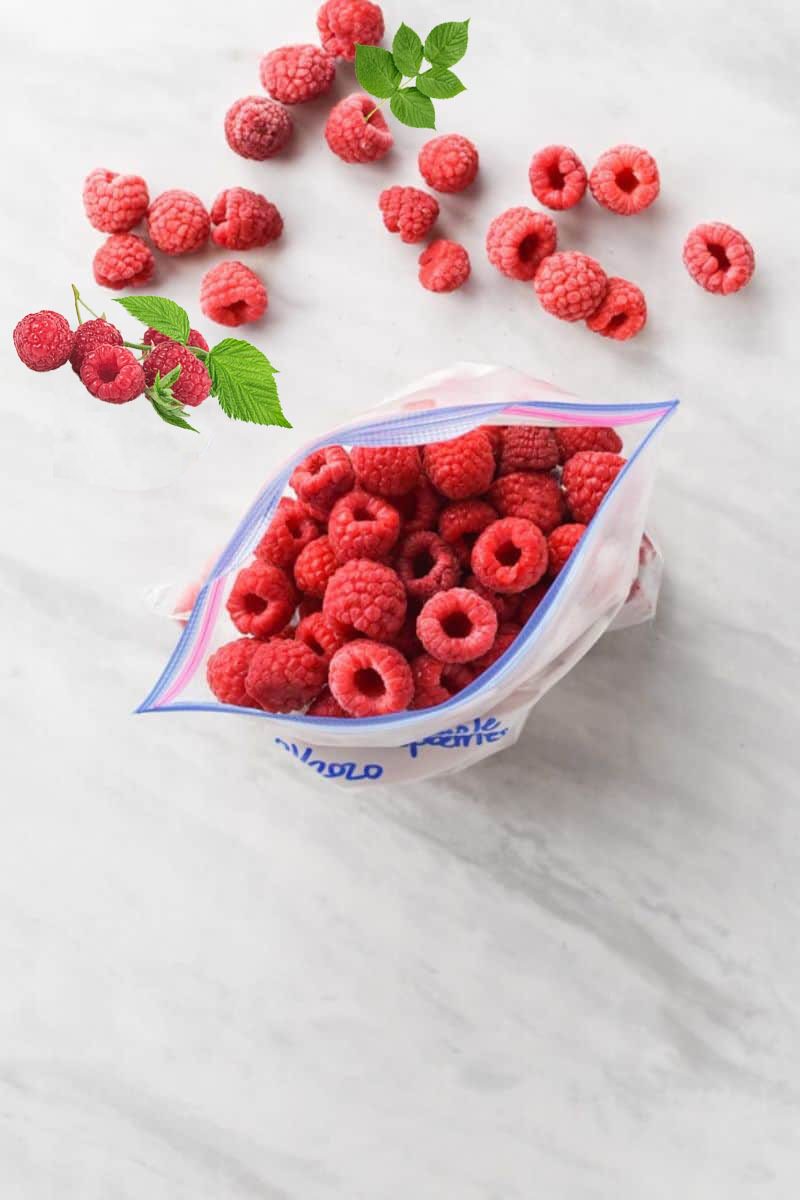How To Freeze Raspberries

Key Takeaways
1. Freezing raspberries is a quick and simple process, taking only about 15 minutes, and it’s the best way to extend their short shelf life.
2. To freeze raspberries, start by sorting and washing them, then spread them in a single layer on a baking sheet to freeze individually, preventing them from sticking together.
3. Once frozen, transfer the raspberries to airtight containers or freezer bags, removing excess air to prevent freezer burn, and label with the date of freezing.
4. Frozen raspberries can be stored for up to 9-12 months, but it’s best to consume them within the first 6 months for optimal taste and texture. They can be used directly from the freezer in various recipes or thawed for later use.
Freezing raspberries is a quick and easy procedure. It will take you 15 minutes. In this article we will teach you how to freeze them and how to use the frozen raspberries. They have a short life span in the fridge so freezing is the best way to store them.
How to Freeze Raspberries?
Freezing raspberries is an easy and quick process and a good way to keep them fresh and ready for some delicious recipes.
Step 1: Prepare the berries
Sort through the raspberries and pick out the soft, moldy, or rotten ones. Right before the berries go off the texture will change and it will be very soft. You can still freeze them but they will become softer after freezing. You could cook them and make a berry jam.
Step 2: Wash Raspberries

Wash the raspberries in cold water using a colander to make sure they have no germs or dirt on them and make sure they are clean. Shake your colander to get drain the excess water out. Put the raspberries on a tea towel to air dry for 15 -30 minutes then pat them dry with ur tea towel.
Step 3: Freezing Berries On Baking Paper

Put your raspberries on baking paper and make sure the berries are separated and not touching one another. This will help to ensure when you freeze them they will not stick together. Put the baking paper in the freezer for at least 30 or so minutes or until your berries are fully frozen.
Step 4: Moving Raspberries to containers or zip lock bags

You can get the baking paper out of your freezer and now it’s time to remove the raspberries from its baking paper and freeze them. Put your frozen berries in a zip lock bag and remove the excess air from its bag, you can also use a container if you prefer. Make sure the container lid is on properly and you can put it in your freezer for when you are ready to use them.
What Can You Do With Frozen Raspberries?
Frozen raspberries are easier to use in recipes rather than fresh. Here are some ways to use frozen raspberries
- Juice or Smoothie: You can make a juice or a smoothie. Place the frozen raspberries in your blender with anything you choose to do with them. If you want to make juice use water or if you choose to make a smoothie use milk.
- Toppings: Use your frozen raspberries in your morning oats, on pancakes, put on cereal. French toast.
- Ice-Cream: Want to make some quick and simple ice cream here is how to do it. You will need to blend your frozen raspberries with other fruits you prefer. You can add some yogurt of your choosing. Your frozen raspberries will keep your dessert cold. It’s ready to eat as soon as you take it out of the blender
- Jam: Raspberries are good for making jam. It will be perfect on toast or on a sandwich. You could use it on almost anything.
- Compote: You can use the raspberries for a pie filling or you can use them as a compote. Slowly heat the frozen berries and add some sugar. Use a wooden spoon to mash up the berries to bring their juice out. The juice from the berries will have a small amount of pectin along with some sugar which gives you a flavourful and thick syrup consistency. You can add this compote to anything.
- Baking: Raspberries are good for baking with you can make scones, muffins, a slice, raspberry cake. The chooses are endless. Let your imagination run free.
Best Way to Freeze Raspberries
The best way to freeze raspberries is to follow these steps:
- Preparation: Gently wash the raspberries under cold water and remove any damaged or spoiled berries. Allow them to air dry or gently pat them dry with paper towels.
- Dry: Ensure the raspberries are thoroughly dry to prevent them from sticking together when frozen.
- Spread on a Baking Sheet: Line a baking sheet with parchment paper or a silicone baking mat. Spread the raspberries in a single layer on the baking sheet, making sure they are not touching each other.
- Flash Freeze: Place the baking sheet with the raspberries in the freezer and let them freeze for about 1 to 2 hours, or until they are firm.
- Transfer to Containers or Bags: Once the raspberries are frozen, transfer them to freezer-safe containers or resealable plastic bags. Remove as much air as possible from the bags before sealing them shut to prevent freezer burn. Alternatively, you can use a vacuum sealer for airtight packaging.
- Label and Date: Label the containers or bags with the date of freezing. This helps you keep track of how long they’ve been in the freezer.
- Store: Place the containers or bags of raspberries in the freezer. They can typically be stored for up to 6 to 12 months.
By freezing the raspberries individually on a baking sheet before transferring them to containers or bags, you prevent them from clumping together, making it easier to take out the desired amount when needed. This method helps preserve the raspberries’ quality and texture.
FAQS
Can You Freeze Raspberries?
Yes, you can freeze raspberries. Freezing raspberries is a great way to preserve them for later use, especially if you have a surplus of fresh raspberries. Here’s how you can freeze them:
- Prep Raspberries: Start by gently washing the raspberries under cold water. Be careful not to crush or bruise them while washing. Remove any damaged or spoiled berries.
- Dry: After washing, gently pat the raspberries dry with paper towels or let them air dry on a clean kitchen towel. Excess moisture can cause them to freeze together in clumps.
- Spread on a Tray: Arrange the raspberries in a single layer on a baking sheet or tray lined with parchment paper. Make sure the berries are not touching each other.
- Flash Freeze: Place the tray of raspberries in the freezer and let them freeze for a few hours, or until they are completely frozen solid. This initial freezing on a tray will prevent the berries from sticking together later on.
- Transfer to Containers or Bags: Once the raspberries are frozen solid, transfer them to freezer-safe containers or resealable plastic bags. Remove as much air as possible from the bags before sealing them shut to prevent freezer burn.
- Label and Store: Label the containers or bags with the date of freezing and store them in the freezer. Raspberries can typically be stored in the freezer for up to 6 to 12 months.
When you’re ready to use the frozen raspberries, simply take out the desired amount and thaw them in the refrigerator or at room temperature. You can use them in smoothies, baked goods, sauces, or desserts. Avoid thawing and refreezing raspberries multiple times as this can degrade their quality.
Do You Wash Raspberries Before You Freeze Them?
Yes, it’s generally a good idea to wash raspberries before freezing them. Washing helps remove any dirt, debris, or pesticide residue that may be present on the berries. Here’s a simple process for washing raspberries before freezing:
- Place the raspberries in a colander or strainer.
- Gently rinse the raspberries under cold running water. Be careful not to use hot water, as it can cause the berries to become mushy.
- Use your fingers to gently agitate the raspberries while rinsing to ensure thorough cleaning.
- Once the raspberries are clean, spread them out on a clean kitchen towel or paper towels to dry briefly.
- If desired, you can pat them gently with another towel to remove excess moisture.
- Once the raspberries are dry, you can proceed to freeze them.
After washing and drying the raspberries, you can freeze them on a baking sheet in a single layer to prevent them from clumping together, then transfer them to a freezer-safe container or bag once they’re frozen solid. This will help ensure that you can easily take out the desired amount of raspberries when you need them without them sticking together.
Are my Frozen Raspberries Bad?
These are some signs your raspberries might be bad
- Your raspberries having some frost or ice crystals on them
- There will be a lot of air in your ziplock bag
- The berries have been in there for longer than a year
- Raspberries will have a light color and they will feel very dry.
Can I Freeze Fresh Raspberries?
Yes, you can absolutely freeze fresh raspberries. Freezing fresh raspberries is a great way to preserve them for later use, especially if you have a large quantity and want to enjoy them beyond their typical shelf life. Here’s a simple method for freezing fresh raspberries:
- Preparation: Start by sorting through the raspberries and discarding any that are overly soft, bruised, or moldy. This ensures that you’re only freezing the best quality berries.
- Wash: Rinse the raspberries gently under cold running water to remove any dirt, debris, or pesticide residue. Be careful not to use hot water, as it can cause the berries to become mushy. You can use a colander or strainer for this step.
- Dry: After washing, spread the raspberries out on a clean kitchen towel or paper towels to dry briefly. You can also pat them gently with another towel to remove excess moisture.
- Freezing: Once the raspberries are dry, you have a couple of options for freezing:
- Single layer freezing: Spread the raspberries out on a baking sheet in a single layer, making sure they’re not touching each other. Place the baking sheet in the freezer for a few hours until the raspberries are frozen solid.
- Container or bag: Once frozen, transfer the raspberries to a freezer-safe container or bag. Make sure to remove as much air as possible from the container or bag before sealing it to prevent freezer burn. Label the container or bag with the date for easy reference.
- Storage: Store the frozen raspberries in the freezer. They should keep well for several months.
Frozen raspberries can be used in various recipes, such as smoothies, sauces, jams, or baked goods. They’re also great for simply thawing and enjoying as a snack or topping for yogurt or oatmeal.
How Long Can Frozen Raspberries Last Frozen?
Frozen raspberries will last 6 months to 1 year in the freezer in the zip lock bags or the container. They can still be consumed after one year but they could have some freezer burn on them and won’t taste as nice.
How Long Can You Freeze Raspberries?
Raspberries can typically be frozen for up to 9-12 months without significant loss of quality if stored properly. However, it’s best to consume them within the first 6 months for optimal taste and texture. Over time, frozen raspberries may start to develop freezer burn or lose some of their flavor and texture.
To ensure the best quality, make sure to store the frozen raspberries in airtight containers or freezer bags to prevent freezer burn. Label the containers or bags with the date of freezing so you can keep track of how long they’ve been in the freezer. Additionally, maintaining a consistent temperature in your freezer helps preserve the quality of the raspberries.
If you notice any signs of freezer burn or if the raspberries develop an off odor or flavor, it’s best to discard them as they may no longer be suitable for consumption.
Do You Need To Thaw Raspberries Before Using Or Baking?
No, you do not need to thaw out your raspberries before baking, but if you decide you want to thaw them out you can put them under cold water for 2 minutes. if you want to use it on the same day but later you can keep them in the zip lock bag or container and leave them in the fridge to defrost. There will be some liquid in the bag but you can just put that extra liquid down the sink there is no need to use that liquid.
Conclusion
Freezing raspberries will save you time and money. Make sure to label your zip lock bags so you can easily find them in your freezer. Flatter the bag and let all the air out to have extra space in your freezer and you can use them at any time.



